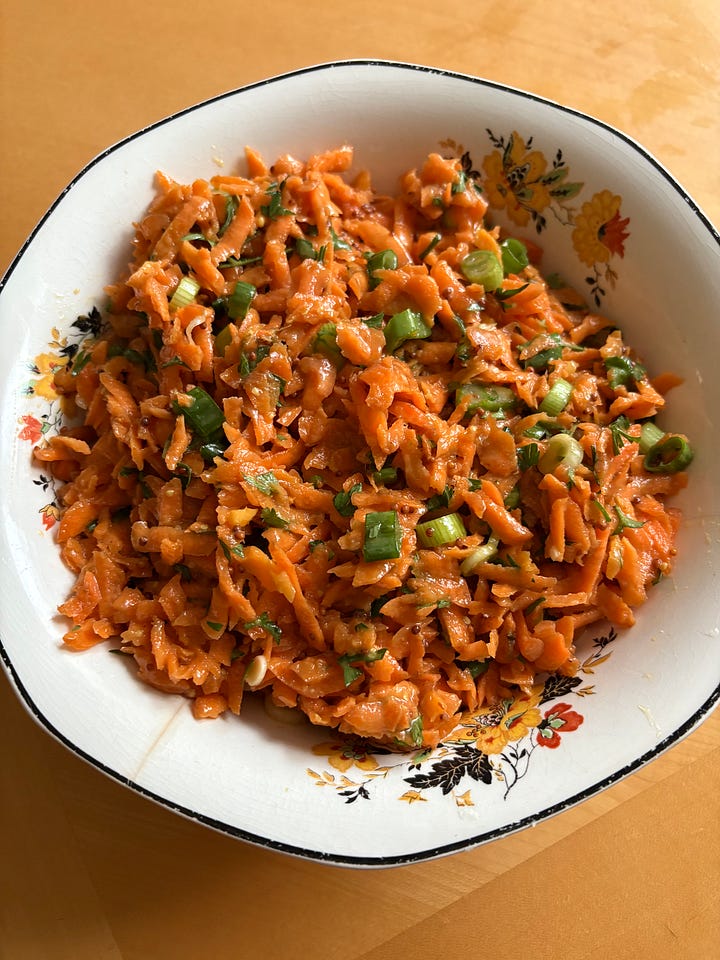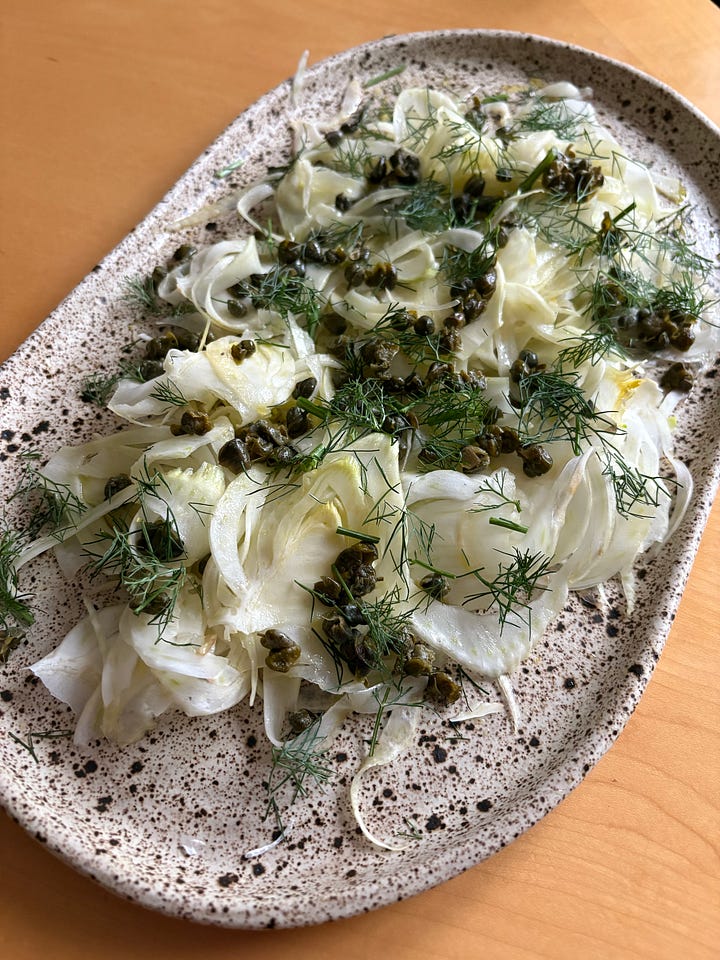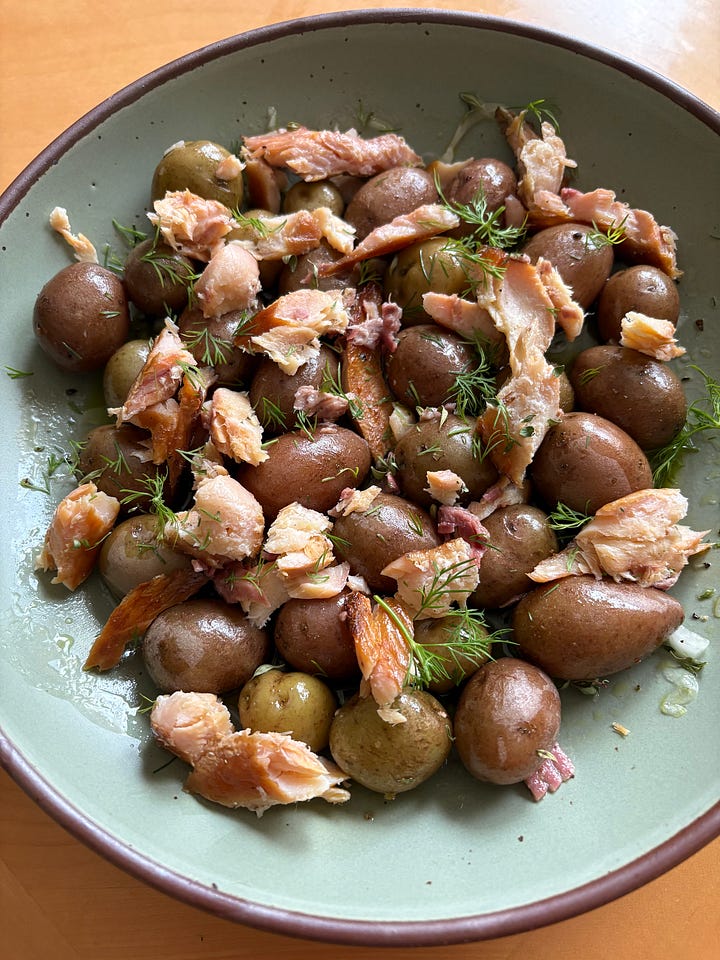Welcome to the Michelle Seguin MD newsletter! I’m Dr. Michelle, and I’m grateful you’re here as part of our growing community of nearly 900 readers across 46 states and 30 countries. This week, we’re diving into the art of seasonal cooking with Salad Seasons by Sheela Prakash—a book that challenges the idea of what a salad can be.
Hello friends,
For this month’s Savor the Seasons Cookbook Club, we are featuring Salad Seasons by Sheela Prakash. This book is a vibrant celebration of seasonal, vegetable-forward cooking, redefining what a salad can be. It’s a reminder that nourishing meals don’t have to be complicated—sometimes, the simplest ingredients, prepared with care, are the most satisfying at anytime of the year.
Whether you’re looking to expand your salad repertoire, discover new ways to enjoy seasonal produce, or simply appreciate the fresh, vibrant side of eating well, I’m so glad you’re here. Let’s dive in!
With gratitude,
Dr. Michelle

Background on Salad Seasons
Salad Seasons is more than just a book of salad recipes—it’s a thoughtful guide to eating with the rhythm of the seasons. Sheela Prakash moves beyond the idea of salads as an afterthought or something reserved for warm weather. As she shared in her Splendid Table interview, one of the biggest myths she wants to dispel is that salads are a chore to eat. Instead, she sees them as a joyful, ever-evolving way to highlight fresh, seasonal ingredients. She also challenges the belief that salad season runs only from Memorial Day to Labor Day, reminding us that every season brings its own unique offerings to the table.
Sheela takes a broad and creative approach to what defines a salad. To her, a salad isn’t just a bowl of leafy greens—it’s any produce-forward dish that includes a thoughtful balance of dressing and texture. This could mean a bright winter citrus salad, a hearty potato and salmon dish, or even a fruit-forward salad that leans sweet. She categorizes salads into three main types: sides, stars, and sweets. Some salads play a supporting role in a meal, while others are filling and complex enough to be the main event. Then there are those that showcase fruit, offering a refreshing way to finish a meal similar to what I observed in Italy.
At the heart of her approach is a simple but effective formula: start with fresh produce, add a dressing that balances acid and sweetness, and layer in contrasting textures like nuts, cheese, or crispy elements. This way of thinking about salads makes them endlessly adaptable and helps highlight vegetables in new and exciting ways, no matter the time of year.
What’s on the Menu
This month, I chose recipes that truly embrace Salad Seasons’ philosophy—fresh, vibrant, and in tune with the natural rhythm of the seasons. Since we’re still in transition here in the Upper Midwest, I selected recipes that highlight storage crops—those hardy, nourishing ingredients that have carried us through the colder months. But with the snow slowly fading and the days growing longer, I’m already looking forward to next month, when we can finally welcome more traditional spring ingredients.
I love how these recipes challenge the idea that salads are just a pile of greens tossed in dressing (don’t get me wrong—I adore those greens). Instead, these recipes showcase produce in all its forms—shaved, marinated, roasted, or simply left raw to shine in its purest state. They celebrate contrast: bitter and sweet, creamy and crisp, earthy and zesty. And as I cooked my way through them, I found myself rethinking what a “salad” really is—not a rigid category, but an open invitation to experiment and explore.
Here’s what’s on my table this month:
Arugula Salad with Whole-Lemon Vinaigrette (p. 18)
Rating: Bright & Balanced
This salad is all about simple ingredients that shine—peppery arugula paired with a dressing that uses the whole lemon, skin and all, for extra depth. The result is a salad that’s vibrant, slightly bitter, and bursting with citrusy freshness. It’s the perfect way to wake up your palate after the heaviness of winter meals.
Beyond its bright flavor, this dish is packed with health benefits. Arugula is a cruciferous vegetable, rich in glucosinolates, which support detoxification and cellular health. Its peppery bite comes from these compounds that aid digestion and may help lower inflammation. Lemons, particularly when consumed whole, provide vitamin C, fiber, and flavonoids that support immune function and heart health. We absolutely loved this dressing, and I served the leftovers the next morning with a couple of poached eggs for a beautiful breakfast salad.
Mustardy Carrot Slaw (p. 21)
Rating: Crunchy & Tangy
A crunchy, colorful slaw with just the right amount of mustardy kick. Carrots bring natural sweetness, while the dressing provides a punch of acidity and spice, making this an ideal side dish for transitioning into spring.
Carrots are a powerhouse of beta-carotene, a precursor to vitamin A, which is essential for eye health, immune function, and skin repair. Mustard seeds are rich in glucosinolates, sulfur-containing compounds that support the body’s natural detoxification pathways and may help reduce inflammation. I have a feeling this salad will travel very well, and I’m already thinking about making another batch for our road trip next week.
Marinated Fennel Salad with Crispy Fried Capers (p. 22)
Rating: Bold & Briny
Fennel’s natural sweetness is balanced with the salty crunch of fried capers, making this a dish full of contrast and intrigue. Similar to last month's fennel salad, a mandoline slicer is especially helpful for achieving super-thin slices, allowing the fennel to take on a delicate, almost translucent quality that enhances its crisp texture.
Fennel has long been used as a digestive aid, thanks to its high concentration of anethole, a compound that helps reduce bloating and support gut health. It also contains fiber and prebiotics, which nourish beneficial gut bacteria. Capers, despite their small size, are rich in quercetin, an antioxidant with anti-inflammatory properties. Their briny, salty punch adds depth to dishes and may subtly support digestion, much like other bitter and astringent foods.
Herbed New Potato and Salmon Salad (p. 54)
Rating: Hearty & Comforting
A reminder that salads can be as substantial as they are refreshing. Tender new potatoes and rich smoked fish are brought together with fresh herbs for a dish that’s as comforting as it is light. It’s the perfect bridge between seasons—hearty enough for chilly days, yet bright enough to welcome the arrival of spring.
New potatoes are an excellent source of resistant starch, which feeds beneficial gut bacteria and supports metabolic health. To maximize these benefits, cook the potatoes, then cool them before reheating and serving. Salmon (or in my case, smoked lake trout fresh from Lake Superior) is packed with omega-3 fatty acids, which help reduce inflammation, support brain health, and promote heart health.




1. Arugula Salad with Whole-Lemon Vinaigrette 2. Mustardy Carrot Slaw 3. Marinated Fennel Salad with Crispy Fried Capers 4. Herbed New Potato and Salmon Salad
Reflections
One of the joys of a cookbook club is the opportunity to reflect—not just on the recipes, but on the experience of cooking and eating. Salad Seasons challenges us to rethink what a salad can be, expanding our definition beyond leafy greens to something more vibrant, textural, and deeply nourishing.
As you explore this month’s selections, here are a few questions to spark your reflections:
Which recipe surprised you the most—either in flavor, texture, or how satisfying it was?
Did Salad Seasons change the way you think about salads? If so, how?
What was your favorite layering of textures in these dishes? Did anything stand out as particularly delightful?
Did you discover a new technique, ingredient, or combination you’d like to carry into your everyday cooking?
If you could add one more salad from the book to this month’s lineup, what would it be?
I’d love to hear from you! Your stories and experiences add so much to this community. Feel free to share your reflections, questions, or favorite moments in the comments below.
Week 3 snuck up on me this month, and between prepping for the seed swap event (which was SO much fun!), I didn’t get a chance to record a Kitchen Conversation segment. But don’t worry—I have something special in store! I’ll be sharing a recorded segment with you at the end of the month.
In the meantime, I wanted to leave you with an inspiring video that beautifully captures the essence of gardening and dietary diversity—something I highlighted during my seed swap presentation and in last week’s newsletter. I hope it sparks as much inspiration for you as it did for me!
In Closing
Thank you for being part of Savor the Seasons Cookbook Club. Cooking is about so much more than just nourishment—it’s an invitation to slow down, connect, and embrace the beauty of seasonal eating.
I can’t wait to hear how these recipes inspire you! Next week, I’ll introduce April’s featured cookbook and give you a sneak peek at what’s to come. (Hint: Think Spring flavors and an ode to Earth Day!)
Until then, happy cooking!
With love and care,
Dr. Michelle
Physician, Gardener, Home Cook, and Forever Curious
P.S. If this newsletter resonated with you, consider liking it and sharing it with a friend. Our growing community is a space for seasonal living, nourishing meals, and deep connection—including our Savor the Seasons Cookbook Club, where we cook and learn together through the lens of seasonal eating. Thank you for being here—your presence means so much to me.
Here are my most recent Substack sharings:
Growing Together - How Dietary Diversity Strengthens Our Health & Communities







What a great treasure of seasonal flavors. I get hungry just looking at the food pics too 👏🏻👏🏻. I love the salad choices this time of year too.
As I mentioned when I saw you in the library, I am tempted to buy this cookbook to add to my collection. I did some googling and found some more of her writing here https://www.sheelaprakash.com/writing